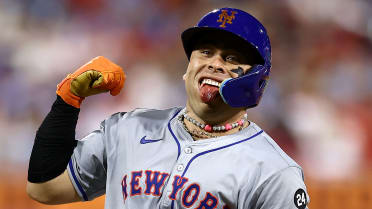Re-visiting home run No. 62 through Bryan Hoch's new book
The following is an excerpt from Bryan Hoch’s new book, “62: Aaron Judge, the New York Yankees and the Pursuit of Greatness,” which is available now from Atria Books.
Something felt a tick or two off with Aaron Judge’s swing, and he was running out of time to correct it.
It had been six days since Judge had equaled Roger Maris’s American League record with home run No. 61. The dream scenario had been for Judge to launch a 62nd home run at Yankee Stadium, the brightness of his white pinstripes eclipsed only by the flashes from thousands of digital devices, all held high in hopes of recording history.
Alas, if that moment were to occur, it would happen some 1,500 miles southwest in Arlington, Texas. Judge’s chances of surpassing Maris in front of a Bronx crowd fell short on the afternoon of October 2, when he struck out three times with a walk against the Baltimore Orioles in the Yankees’ final regular season home game.
From New York’s perspective, Judge’s at-bats were the most compelling reason to observe that series, with the American League East clinched and the rest of the roster in tune-up mode for the playoffs. If not for the home run chase, a forecast of inclement weather might have tempted cancellation; instead, the clubs played through light to steady precipitation, remnants from Hurricane Ian, which had pounded Florida’s west coast earlier in the week.
Now they were off to Arlington, and as Judge dressed in a comfortable team-issued Nike tracksuit for the flight, he expressed regret that No. 62 had not been slugged in front of his most adoring audience.
“It’d be nice to hit it at home and do something special like that for the home fans, but at the end of the day, I’ve got a job to do,” Judge said. “I’ve got to get ready for the postseason. It didn’t happen [at Yankee Stadium], but the season’s not over yet.”
Indeed it was not. Against the Orioles, he’d singled with two walks and a strikeout in the first game. October 1 marked the sixty-first anniversary of Maris’s 61st, but there was no symmetry to be had. Judge went hitless with a pair of strikeouts and walks that day, a Saturday contest for which ABC and ESPN interrupted a second consecutive week of college football telecasts, offering live cut-ins to Judge’s at-bats.
The gridiron audience had fatigued of the interruptions; calling a game between Ole Miss and Kentucky, announcer Sean McDonough was told that the tarp had been placed on the field at Yankee Stadium. “Oh, what a shame,” McDonough said, his tone dripping with sarcasm. McDonough had not been thrilled the previous week, either, when Judge’s at-bat stomped over his call of Clemson’s game at Wake Forest.
Of course, Judge had nothing to do with network programming decisions, though he was trying like heck to provide some good TV. After days of Judge tossing his bat aside at an unappetizing buffet of sliders and fastballs outside the strike zone, the Orioles gave Judge a few pitches to hit. None were put in play; facing Baltimore starter Kyle Bradish, Judge struck out looking in the first inning, whiffed in the third, then worked a five-pitch walk in the fifth. An opportunity to witness Judge trot to first base with a free pass was not what drew 44,322 fans to the corner of 161st Street and River Avenue on a gray, chilly afternoon. The crowd jeered Bradish for each pitch not grooved down Broadway, then sighed when Judge struck out against reliever Bryan Baker in the seventh inning.
Judge insisted that the scrutiny of the chase had not gotten to him, but he knew his swing and worried that something had gone awry within the last few weeks. It was probably imperceptible to the naked eye, but significant enough that it could throw him out of whack, a significant concern with the postseason just days away. The building blocks of Judge’s swing came with trying to stroke hits, not belt homers, and he was getting away from that.
As Judge’s batting average ticked downward, Luis Arraez’s numbers remained the same. Though the Minnesota Twins infielder dealt with left hamstring tightness that kept him out of the lineup for a few games, Judge still considered a Triple Crown within reach. He couldn’t force the Twins to play Arraez (whom, to his credit, said that he wanted to “win the batting title fighting”), but he could attempt to focus on hits instead of the long ball.
“If I have a good approach, the home runs are going to come,” Judge said. “It was about trying to get on base, drive guys in and get hits. That Triple Crown was kind of at the forefront for me. I felt like, if I could get four or five hits a game, it’s going to help our team win. It was a challenge, but I had fun throughout the whole thing. We had clinched our division, so the last couple of games were just about getting ourselves in the right position for the postseason.”
The Yankees had four regular season games remaining, against the Rangers at Globe Life Field in Arlington, Texas. The trip included a split-admission doubleheader, and Judge told Aaron Boone that he’d like to play every day, but maybe not both ends of the twin bill. Noting that there were several days off between the end of the regular season and the beginning of the American League Division Series, Judge told the manager, “That’s when I’ll rest.”
For weeks, each of Judge’s at-bats had carried the weight of history, and he was pleased to cede that spotlight in the first game at Texas. That was Luis Severino’s turn to flirt with immortality, the right-hander proclaiming his “1,000 percent” certainty that he would’ve completed a no-hitter if given the chance.
Making his final tune-up before the playoffs, Severino had his arsenal crackling over seven hitless innings, facing the minimum before a rising pitch count forced the Yankees to turn the game over to the bullpen in a 3–1 victory. Severino struck out seven, the last of which was a swinging punch-out of Nathaniel Lowe, prompting Boone to intercept the right-hander at the dugout stairs.
Boone placed his hands on Severino’s shoulders, asking, “What do you think?” When Severino replied, “I would die out there,” Boone shook his head and was firm, saying, “I can’t let you do it.” Severino refused to make eye contact, the emotions of the moment overwhelming him.
It was only Severino’s third big-league game since returning from the strained right lat that had removed him from the rotation in July, and Severino had been briefed about his pitch count limitations. Though Boone said that having to remove Severino put “a little damper on the night,” he also believed that, if Severino were to have a realistic chance of completing a no-hitter, he might have to throw 120 to 130 pitches. These opportunities were rare; no one could promise Severino he’d ever have another opportunity for immortality.
Yet once the fog of battle had cleared, Severino stood at the center of the visiting clubhouse and admitted that he thought it “was a good decision,” noting, “I don’t want to go out there and hurt myself and not be good for the postseason.”
As Severino and his teammates lamented what might have been, Judge set out to investigate what was holding him back from history. Held to a checked-swing infield single in four at-bats that night, Judge pulled out his iPhone and tapped a message to his swing guru, Richard Schenck, who had been watching the game from his home in St. Peters, Missouri. Judge provided Schenck with a link to a video of his most recent batting practice session.
“I think my direction has been off, and it looks better here,” Judge wrote. Schenck watched the video, then offered: “Yeah, I agree with you.” Judge thanked Schenck, tucking away a note for the next day.
HOMER #62: October 4 vs. Texas Rangers’ Jesús Tinoco (1st inning, solo) Exit velocity: 100.2 mph. Distance: 391 feet. Launch angle: 35 degrees. HR in 29 of 30 MLB parks.
October 4 dawned sunny and temperate in Arlington, Texas, with forecasted temperatures in the mid-eighties. That prompted the Rangers to announce that the roof at Globe Life Field—the largest single-panel operable roof in the world, weighing a whopping 24 million pounds— would remain closed for the first game of the doubleheader. A major factor in the reason why the Rangers had built their $1.1 billion colossus was to escape the broiling heat at their former venue across East Randol Mill Road, where there had been no roof and spotty air-conditioning.
The Yankees and Rangers were scheduled for a day-night doubleheader, and if not for the Judge chase, there would have been almost no reason to watch. No one in uniform seemed excited about adding a long day to the end of a long season, slapped on as part of the fallout from an ugly and contentious spring lockout. The Yankees had originally been booked to begin their 162-game schedule in Arlington; instead, they would finish it there. The first game of the day saw Judge notch a single and a run scored in New York’s 5–4 win, a contest in which the normally stoic Judge had shown a few flickers of frustration. He’d bashed his batting helmet after popping up a hittable pitch from Rangers right-hander Jon Gray; true to form, though, Judge apologetically picked the helmet up from the dugout floor and placed it in its appropriate slot. Judge usually saved those outbursts for the runway between the clubhouse and the dugout, where television cameras couldn’t capture it. This time, he didn’t hold back.
“It was the first time I’d seen it wearing on him, just a little bit,” Cole said. “We just wanted it to happen so bad.”
Judge’s late-night text message to Schenck had not come out of nowhere. He was in a mini-slump, batting .231 (9-for-39) with a homer, eighteen walks, and fifteen strikeouts since hitting No. 60 off the Pittsburgh Pirates’ Wil Crowe. Some of the opponents had shied away from Judge, but not Texas. As Tony Beasley, the Rangers’ interim manager, said: “We were pitching to him. We had no intention of trying to walk him. We were trying to execute pitches and get him out. The guys behind him can hurt you, so we attacked him with our game plan.”
Still, Judge’s focus seemed sharp; one violent swing could make those statistics irrelevant. As the first 30,553 fans of the day filed out of Globe Life Field, many remaining close by to seek refreshments at the adjacent Texas Live! bar before returning for the nightcap, Boone stopped by Judge’s locker for a status check. Their conversation was brief, as Boone expected. Judge promised the manager that he was ready to go. Boone nodded, then returned to his office, finalizing the lineup card that he’d already decided on. In the top spot, Boone wrote: “Judge, RF.”
The temperature had dipped to eighty-one degrees, and the Rangers announced that the roof would be open for the evening game, which locals swore helped the ball travel better. Boone said he hoped that was true. The clock ticked to 7:05 p.m. Central time—“It’s baseball time in Arlington,” longtime public address announcer Chuck Morgan bellowed, with echoing vibrato. Judge was the final player in the underground batting cage, completing his pregame routine before striding to home plate. He blinked twice and took his familiar stance, feet spread and bat cocked stiffly behind his right shoulder.
Standing six foot four and weighing 258 pounds, Jesús Tinoco had followed his big-league dreams from the dusty streets of San Antonio de Maturín, Venezuela. The hard-throwing right-hander had already participated in forty-seven previous big-league games, wearing the uniforms of the Colorado Rockies, Miami Marlins, and now the Rangers. Assigned to serve as an “opener” in the second game of this doubleheader, game No. 48 would be by far the most watched appearance of his twenty-seven years.
Tinoco had a few pitches at his disposal; he favored his sinker and slider, occasionally mixing in a curveball or four-seam fastball. He threw a ball, then a strike, setting up a 1-1 offering. Catcher Sam Huff set a target and Tinoco reared back to fire a slider, leaving it over the plate. Judge barreled the ball; it rocketed off his bat and soared deep to left field, where outfielder Bubba Thompson trotted back toward the 372- foot marker on the wall, little more than a curious witness to history.
“I had a good feeling off the bat,” Judge said. “I just didn’t know where it was going to land or what it was going to hit.”
“High fly ball! Deep left! There it goes!” Michael Kay announced on the YES Network broadcast. “Soaring into history! He’s done it! He has done it! 62! Aaron Judge is the American League single-season home-run leader!”
On the radio broadcast, John Sterling gave his trademark, “It is high, it is far, it is gone!” then added: “Number 62 to set the new American League record! Aaron Judge hits his 62nd. All the Yankees out of the dugout to greet him. Just think of it: three Yankee right fielders—the Babe, hitting 60 in ’27, the Jolly Roger, hitting 61 in ’61, and now Aaron Judge hits his 62nd home run—the most home runs any American Leaguer has hit in a single season. And the American League has been alive for 120 years. This is Judgment day. Case closed!”
Former Yankees pitcher Jeff Nelson was by Sterling’s side that day, filling in as a color commentator while Suzyn Waldman observed Yom Kippur. “I was so blessed to be there,” he said. “I just laid back and listened to John make the call. Our broadcast booth was so high up in Texas that even John said, ‘I didn’t know if it was going to go out.’ I said, ‘Good thing you kept rolling with it.’”
Judge watched it all the way, tracking its flight as it cleared the wall and reached the seats. He felt an overwhelming sense of relief, the pressure of the past several weeks immediately lifting from his heavy shoulders.
A crowd of 38,832 roared inside the gleaming, glassy structure on Texas’s north side; Judge’s parents, Patty and Wayne, were in attendance, as was his wife, Samantha, who wore a vintage Mitchell & Ness T-shirt honoring the 1996 World Series championship. The Yankees hurdled the dugout railing and flooded onto the field, screaming and high-fiving each other while Judge rounded the bases. Judge grinned widely, stamping his left foot on home plate and embracing each teammate with the deep hugs usually exchanged between loved ones at airport terminals or train stations. Josh Donaldson said that the moment “felt like the college days,” an opportunity to show the team’s respect for Judge and his accomplishments.
“We were all anticipating it, and the season was running out,” Stanton said. “So obviously, each at-bat was getting bigger and bigger. We all kind of downplayed it and suppressed it as teammates; it was our job to make it as comfortable as possible, and not make a big deal about things. We just tried to be normal. Everyone else was changing and acting differently, but we had the behind-the-scenes view of it, and we knew all the ins and outs. It was great to be a part of and to be able to see every day.”
None of the Yankees’ hitting coaches saw the homer in real time. They were still picking up baseballs in the cage, where Judge had just completed taking his practice swings. Dillon Lawson saw Tinoco on the mound and Judge at the plate on the in-house television feed. “We looked at each other, like, ‘Did the game just start?’” he said. “We took off running. The double doors were open from the clubhouse to the dugout. We got there just in time to hear the crowd gasp. We got to see the ball land, but we didn’t see it hit.”
Neither did Kyle Higashioka, one of the few players still in the clubhouse. “To be honest, the chase had dragged on for a bit. I was searching for whatever I could do to make it happen, superstitionwise. Everybody wanted to be out there, so I was like, ‘I’m going to stay inside.’ Sure enough, he hit it, and I was like, ‘I’ll sacrifice that for him to get 62.’”
Hanging back to let the celebration breathe a bit, Boone said that he was thrilled, not only for Judge, but for Judge’s family and teammates. The manager declared that Judge’s 2022 would be remembered as “a historically great season, and one we’ll talk about when we’re long gone,” the way feats accomplished by Ruth and Maris have endured. The American League (and Yankees) record for home runs finally belonged to Judge, who had clubbed the seventh-most home runs in a single season, behind Barry Bonds (73 in 2001), Mark McGwire (70 in 1998; 65 in 1999), and Sammy Sosa (66 in 1998; 64 in 2001; 63 in 1999).
“It’s a big relief,” Judge said. “I think everybody can finally sit down in their seats and watch the ballgame. It’s been a fun ride so far.”
Senior Reporter Bryan Hoch has covered the Yankees for MLB.com since 2007.




